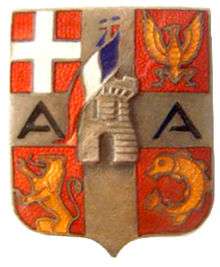Army of the Alps

The Army of the Alps (Armée des Alpes) was one of the French Revolutionary armies. It existed from 1792–1797 and from July to August 1799, and the name was also used on and off until 1939 for France's army on its border with Italy.
1792–1797
The Army of the Alps was created by a decree of the French Convention on 1 October 1792 which divided the Army of the Midi into the Army of the Alps and the Army of the Pyrenees. On 1 November 1793 it was itself divided into the Army of Savoy and the Army of Italy by a conseil exécutif decree.
Following the decrees of 27–29 November 1793 which brought Savoy into the First French Republic under the name of Mont-Blanc department the Army of Savoy was renamed the Army of the Alps, before having the Army before Lyon split off from it between 8 August and 29 October 1793. The Army of the Alps was suppressed by a decree of 21 August 1797 (21 Fructidor year V), put into effect on 13 September, with its men and theatre transferred to the Army of Italy.
1799
Created on 27 July 1799, this incarnation of the Army of the Alps only lasted until 29 August 1799, when it was merged into the Army of Italy.
Generals
Army of the Alps
- 8 October – 6 November 1792 : Anne-Pierre de Montesquiou-Fézensac
Army of Savoy
- 7 – 13 November 1792 : Montesquiou-Fézensac
- 13 November – 4 December, temporarily : Jean Jacques de La Roque d'Olès d'Ornac
Army of the Alps
- 5 – 24 December 1792, temporarily : Ornac
- 25 December 1792 – 5 May 1793 : François Christophe Kellermann
- 6 May – 1 June 1793, temporarily : Ornac
- 2 June – 18 October 1793 : Kellermann, along with overall command of the Army of Italy. Kellermann, to whom the representatives on mission were ordered not to immediately communicate the decree by which he was deprived of this command, continued to command on the frontier until 18 October, when he was arrested and taken to Paris.
- 2 June – 2 November : Ornac, second in command of the Army of the Alps
- Army before Lyon:
- 8 – 18 August, Kellermann was at the siege of Lyon
- 19 – 21 August, Jean-Baptiste Louis Philippe de Félix d'Ollières de Sainte-Maime comte du Muy
- 22 – 31 August, Kellermann was in command before Lyon
- 1 September, he went to put himself at the head of the troops guarding the frontier, leaving the besieging division under the command of Guy Coustard de Saint-Lo
- 25 September – 28 October 1793 : François Amédée Doppet, in command before Lyon
- 29 October – 17 November, provisionally : Jean-François Dours
- 18 November – 22 December 1793 : Jean François Carteaux
- 23 December 1793 – 20 January 1794, provisionally : Jean-Louis Pellapra
- 21 January – 14 October 1794 : Thomas-Alexandre Dumas
- 15 October – 30 November 1794, provisionally : Pierre Petitguillaume
- 1 December 1794 – 7 October 1795 : Jean-François-Auguste Moulin, from 5 April subordinate to François Christophe Kellermann
- 5 April 1795 – 13 September 1797 : Kellermann, commander in chief of the Armies of the Alps and Italy until 28 September 1795. He visited all the encampments of the Army of the Alps from 5 to 15 April 1795, then left for the headquarters of the Army of Italy at Nice.
1815
During the Hundred Days, Napoleon activated the Army of the Alps and placed it under the command of Marshal Louis Gabriel Suchet. The force consisted on two regular infantry divisions, one cavalry division, three national guard divisions, and attached artillery. Philibert Jean-Baptiste Curial led the 10-battalion strong 23rd Infantry Division. Jean Mesclop's brigade was made up of three battalions of the 7th Line and two battalions of the 14th Line Infantry Regiment. Jean Louis Eloi Bouvard's brigade comprised three battalions of the 20th Line and two battalions of the 24th Line. Joseph Marie, Count Dessaix commanded the 24th Infantry Division with seven battalions in two brigades. Jean Montfalcon's brigade had three battalions of the 67th Line. Jean Revest's brigade included two battalions each of the 42nd Line and 53rd Line. François Jean Baptiste Quesnel led a cavalry division consisting of only one brigade. Bernard Meyer de Schauensee's brigade consisted of the 10th Chasseurs à Cheval and 18th Dragoon Regiments. The 5th, 6th, and 7th National Guard Divisions were led by Théodore Chabert, Claude Marie Pannetier, and Jean-Pierre Maransin, respectively. The artillery included six foot batteries from the 4th Artillery Regiment and one battery from the 4th Horse Artillery Regiment.[1]
20th Century
In the mid-twentieth century, the Army of the Alps defended France's southeastern frontier with Italy, manning the Alpine Line fortifications of the Maginot Line. The army's commander was General René Olry, headquartered at Valence. Its chief units were the 14th Army Corps in the SF Savoy and SF Dauphiné (Fortified Sectors), and the 15th Army Corps in the SF Maritime Alps.[2]
The army surrendered to German forces at the end of June 1940 in accordance with the terms of the Second Armistice at Compiègne, having repelled Italian forces in the Italian invasion of France.[3]
References
- ↑ Schneid 2002, pp. 205–206.
- ↑ Mary, Tome 5, pp. 4-5
- ↑ Mary, Jean-Yves; Hohnadel, Alain; Sicard, Jacques (2009). Hommes et Ouvrages de la Ligne Maginot, Tome 4 - La fortification alpine (in French). Histoire & Collections. pp. 4–5. ISBN 978-2-915239-46-1.
Sources
- C. Clerget : Tableaux des armées françaises pendant les guerres de la Révolution (Librairie militaire 1905)
- Schneid, Frederick C. (2002). Napoleon's Italian Campaigns: 1805-1815. Westport, Conn.: Praeger Publishers. ISBN 0-275-96875-8.